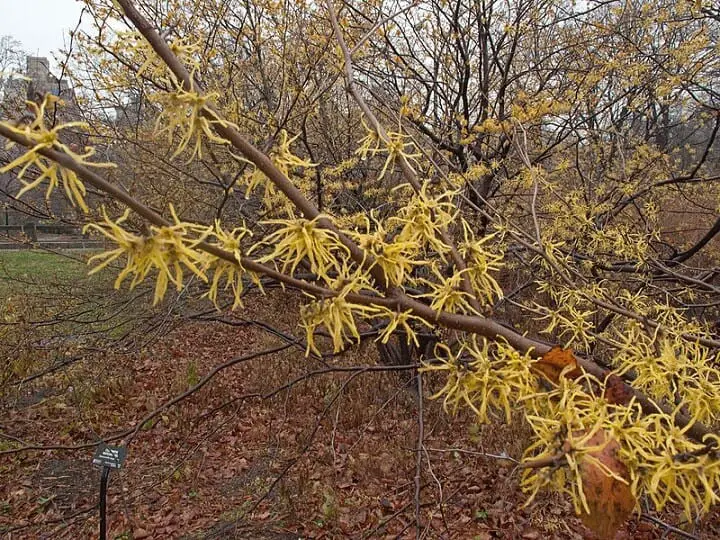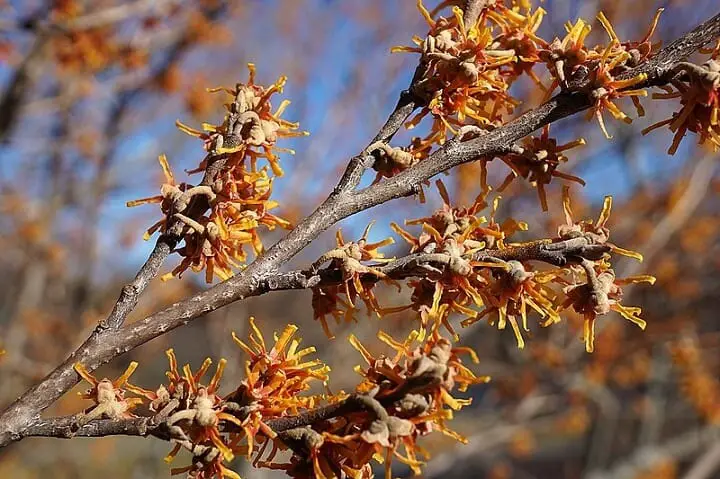Estimated reading time: 6 minutes

Witch hazel has a long and storied history as a remedy for skin afflictions and much more. The use of witch hazel in America dates back to pre-colonial days when natives used it in sweat lodges and for treating colds, coughs, and dysentery.
It is quite possible that Native Americans first suspected something special about the plant upon seeing it flush with blooms in winter, despite completely lacking leaves. This characteristic of witch hazel makes it a beautiful addition to the garden, as it is the last plant to set blooms before winter arrives or the first to bloom in the spring.
Want to save this post for later? Click Here to Pin It On Pinterest!
History of Witch Hazel

Despite its spooky name, the shrub’s name actually comes from the Middle English word “wych,” an ancient term for “bend.” This owes to a reputation for witch hazel switches being used as dowsing sticks – an ancient method of “dowsing” to find underground sources of water. So maybe the name origin is a little spooky after all.
While recognized as a medicinal plant by Native Americans, it was quickly taken up by colonists and was imported to England where it became a popular garden plant. Today, witch hazel is one of the few plants that enjoy popular appeal as a folk remedy and has been FDA approved as well. It is a key ingredient in countless skincare products thanks to its powerful astringent properties.
Native Witch Hazel Varieties

Witch hazel grows as a shrub or a small tree, generally growing to between six and sixteen feet tall. There are only four species of witch hazel (Hamamelis) in the world, and only two of these are native to the United States: those that bloom in the fall and those that bloom in winter.
Common witch hazel, or Hamamelis virginiana, blooms in the fall. Vernal witch hazel, or Hamamelis vernalis, blooms in late winter or early spring. In the places where vernal witch hazel is native, it is known as a harbinger of spring because it is the first flowering woody plant in the landscape. You should choose your variety of witch hazel on the basis of when you most want to see blooms.
Ideal Site Conditions for Witch Hazel
This native plant is unfussy and generally rather cold hardy, but it does have a few strong growing preferences. The shrubs are sun-loving, particularly in the wintertime, but may do poorly in the scorching hot summer sun.
If you can plant it in a location that receives light afternoon shade in summer – for instance as an understory tree – you’ll have more success with your witch hazel. Additionally, a little shelter from cold winter winds will extend the blooming season.
Despite being slow-growing, the growth habit of witch hazel is that of a large, spreading shrub, so be sure to choose a growing location where there is space for your plant to mature gracefully.
Witch hazels thrive in rich, well-drained soil that retains some moisture in summer. Neutral to acid soil with a PH between 4.5 and 6.5 is best for these shrubs, and very chalky alkaline soils must have a significant amount of organic matter added before witch hazel will tolerate them.
How to Plant Witch Hazel

Witch hazel is easy to grow, tolerant of a wide variety of environments, and because it is slow-growing, suitable for planting in a container. The best time to transplant witch hazel into the ground is during cooler months, between October and April.
Of course, this will vary by location – you should never transplant when the ground is frozen or saturated with water. On the other hand, if you choose to grow witch hazel in a container, you can plant it any time of the year.
Bear in mind that if you plant in a container, you will have to pay close attention to keeping the soil moist, especially in the first few months while it is getting established.
Ongoing Care of Witch Hazel
The hardiness of witch hazel makes it straightforward to grow as it is not susceptible to many diseases or insects. If grown in a container, the main concern is that the soil won't be allowed to dry out completely.
In the ground, you will need to water the shrub on a regular basis when it is hot outside for the first couple of years. Once it is established, little water is needed unless it has been a particularly dry season.
Witch hazel plants in pots will benefit from once-a-year fertilization with a general fertilizer. There is no need to prune witch hazel plants, but you should remove any dead or weak shoots or branches.
How to Harvest Witch Hazel
To use witch hazel from your plant, you can harvest any time, but the active components are most potent in the early spring when the leaves are first emerging. Twigs and leaves are both suitable for harvesting, and your best bet is to cut small, leafy branches from mature plants.
You can also strip small sections of outer bark off with a small knife, but take care to never remove bark all the way around a branch or trunk as it can kill the plant.
Processing and Using Witch Hazel

To create an astringent compound like you might buy in a store (but much more concentrated), you will need at least four ounces of witch hazel bark, twigs, and leaves. Here's what to do:
- Place them into a pot and cover with distilled water, at least an inch or two above the level of organic material.
- Heat over medium heat until the water is boiling and then turn the heat down to a low simmer.
- Simmer for 20 minutes covered and remove from heat and leave the tea until it has cooled completely.
- Strain the tea and add one half its volume in grain alcohol or vodka.
- Store it in a cool, dark place and use as needed.
This tonic should be good for a year or two.
For more info, check out our list of uses for witch hazel.
Like this post? Don't Forget to Pin It On Pinterest!











Where would you get these plants or order them from?